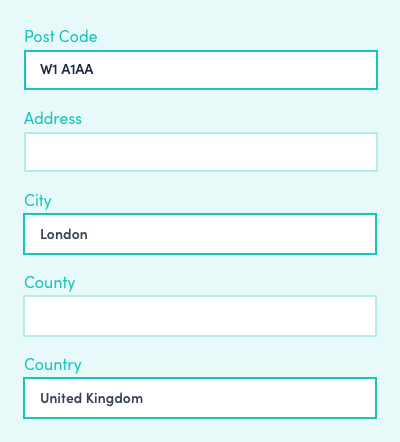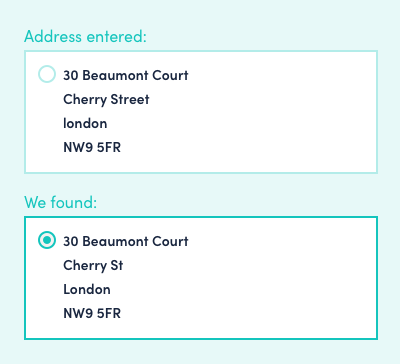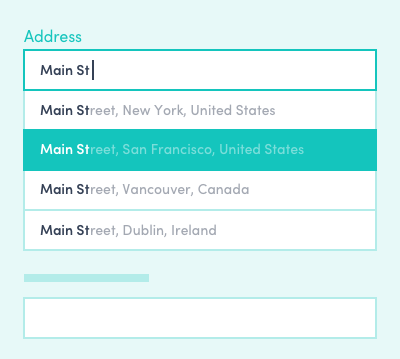Glossary
Address Verification
What is Address Validation?
Address verification (or validation) is a method of looking up or cleansing address data. An address can be verified in one of two ways: by capturing an address in real-time as the end-user inputs a form field or by cleansing, parsing, matching formatting, transliterating and enhancing data in a database against a reference dataset.
Why is Address Validation Important? Key Benefits
One of the biggest difficulties our partners tell us they're dealing with is the speed at which transactions take place nowadays, in a world of digital data exchange.
The good news is that address verification makes this process simple. Examples of the key benefits a solid address verification platform can offer you include the following:
- Simplifying the customer check-out process by auto-completing form fields
- Verifying an address for accuracy, in real-time, during a checkout process
- Geocoding and reverse-geocoding addresses with latitude and longitude data
- Ensuring easy compliance with identity verification practices
- Mapping the distance between two points
- Establishing communication lines with shipping carriers, to anticipate potential delays ahead of time
- Enriching customer records with accurate information, ensuring seamless communication
Address verification is crucial for all companies that need to transact with customers globally. That’s because information is usually stored within different databases or systems of record. For instance, the United States Postal Service (USPS), UPS, FedEx, Canada Post, and a range of national postal carriers maintain their own developer tools and address verification APIs.
Organizations that deal with global customerbases will need a simplified way to communicate with shipping carriers in (potentially) hundreds of countries. That's where address verification comes in.
What are the most common types of address verification?
The most common types of address verification include drop-down verification, partial verification, post-entry verification and type-ahead verification. There are some key divergences between these four types of address verification that are useful to know when you're choosing a type for your website.
Drop-down verification is where the state, county and country fields can be found using a drop-down, as below:

With partial verification, a postal code entry will fill in the city and state or county, while manual entry of the rest of the address is required:

Post-entry verification is where users manually enter an address, then a pop-up shows any alternatives found within the reference database, with the user then asked to choose the correct one:

Type-ahead verification (the kind we at Loqate specialize in!) is where the user starts typing their address into a single field, and as they type, increasingly accurate suggestions are offered. Clicking on a suggestion returns the full address.

What is inline validation?
Inline validation is a real-time method of checking the validity of data input and providing feedback before submission. It significantly enhances the usability and UX of forms, and reduces form abandonment rates by providing a quicker way to enter address details. Loqate’s address verification technology can reduce address entry time by up to 78% and cuts back data entry errors at point of capture by more than 20%, all improving the end user experience.
What is single line address finding?
The single line address lookup layout simplifies your address forms down to just one field. Typing any part of the address on a single line is quick and easy, with the result that address forms occupy less on-page space. Single line address lookup is a more efficient and user-friendly approach to implementing an address look-up, and our UX research shows that users are twice as likely to find an address and input using single line versus multi-line address verification.
How does type-ahead address verification differ from traditional postal code lookup?
Traditional postcode lookup |
Type-ahead |
| Lookup UK addresses | Look up UK and international addresses |
| Enter the postcode to search | Enter any part of an address to begin searching |
| Searches from a whole postcode | Allows you to miss out parts of the address or postcode and returns matches, you don’t need to know the postcode |
| Press a single button to display results | Results are displayed as soon as you start searching |
| No filtering options to narrow results | Narrow results further as you type more details of the address |
| Postcode needs to be typed without errors | Type-ahead understands common misspellings |
| Results ordered alpha-numerically | Option to order results by nearest to the user or your operational location |
| Shows all matching addresses for the postcode | Customisable to show only business or residential addresses, not yet built (NYB) premises and multi-residence data (NOTE: this data is not included as standard) |
| You can auto-complete the address form with the selected address | Selected address auto-completes form - you can reduce your address form to a single line |
| Easy to integrate/install | Easy to integrate/install |
| Address data from Royal Mail's PAF® database | Includes address data from Royal Mail's PAF®, USPS and Canada Post |
| As seen on: Oxfam, flybe, and more | As seen on: ASOS, Graze.com, Superdry and more |
Guide to Address Verification Methods
In any address verification program, there are a plethora of technical processes going on under the hood, so to speak. Understanding them will help you identify use cases for address verification in your business.
Fuzzy Matching
Even if you have a typo in your address query, you can still grab relevant results from the input. An address verification API can detect misspelled or missing information such as spaces and letters to create more accurate results.
This technology is particularly useful for mobile digital environments that are prone to typos due to small screen sizes. "Fuzzy matching", as it's known in the industry, is critical for increasing data quality.
Learn more: What is fuzzy matching?
Geocoding & Reverse Geocoding
Geocoding is the the technical term used for when we assign latitude and longitude coordinates to a geographic location. Reverse geocoding, as the name suggests, is the opposite process, whereby a location is instead appended to a geographic coordinate system.
The geocoding method is handy for visualizing data, augmenting location datasets, and identifying store networks, warehouse locations, events, and other useful info. Geocoding helps with optimizing deliveries, anticipating real-world risks, and providing insight about locations.
Address Standardization
The process of standardizing addresses is key for ensuring that different systems communicate with each other. Every postal system requires its own official format. An API can break unstructured address data into its component parts and automatically reformat addresses into the correct output structure.
Address Verification in North America
There are a number of address verification services and API solutions available to meet the needs of businesses of all stripes. Here are some criteria to consider when selecting address verification technology for you:
- Frequency of data updates
- Processes for safeguarding company data
- Uptime standards
- Ability to address typos
- Data sources and their integrity
- Integration and deployment time
- Back-end address verification to cleanse, parse, and standardize data in integrated software
- Additional services
- Additional datasets
- Customer support options
Learn more: Choosing an address verification provider
As organizations evolve, especially when they scale globally, address verification needs may become more complex. In these situations, paid services are available for APIs that support the following use cases:
- Integrations with multiple postal carriers
- Third-party application development
- Correcting customer-generated errors
- Building a rich database
- Maintaining CRM hygiene
Successful address verification strategies are a key part of helping you reach higher-level business goals such as error reduction, database enrichment, and delivery speed.
Loqate helps businesses around the world verify customer addresses by combining our global datasets with best in class technology. Our easy to integrate API helps our customers verify customer data at the point of capture. Find out more about how Loqate address verification solutions can help your business.